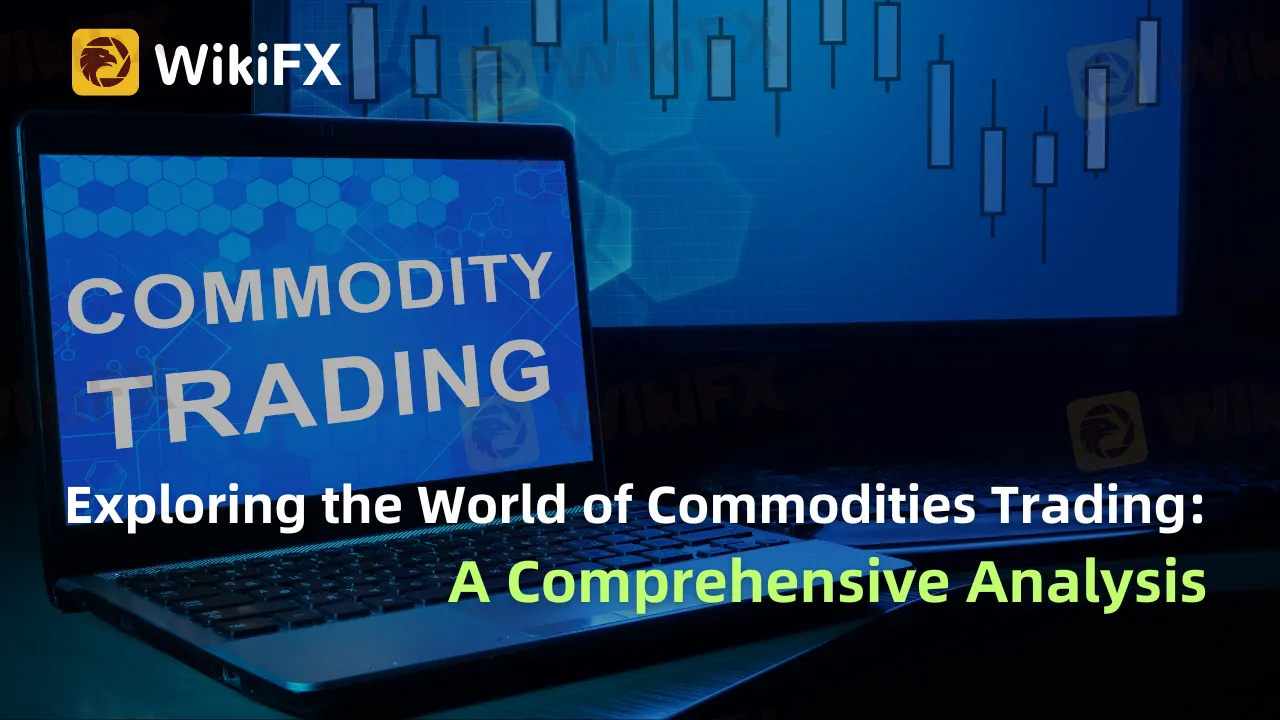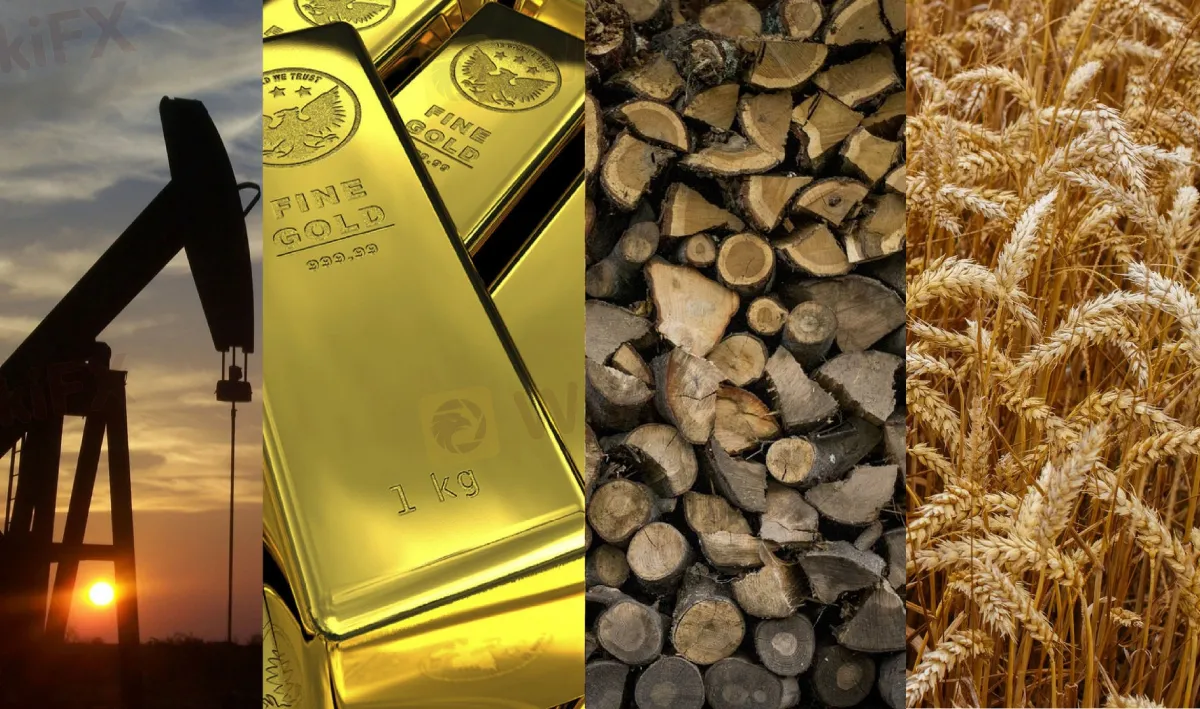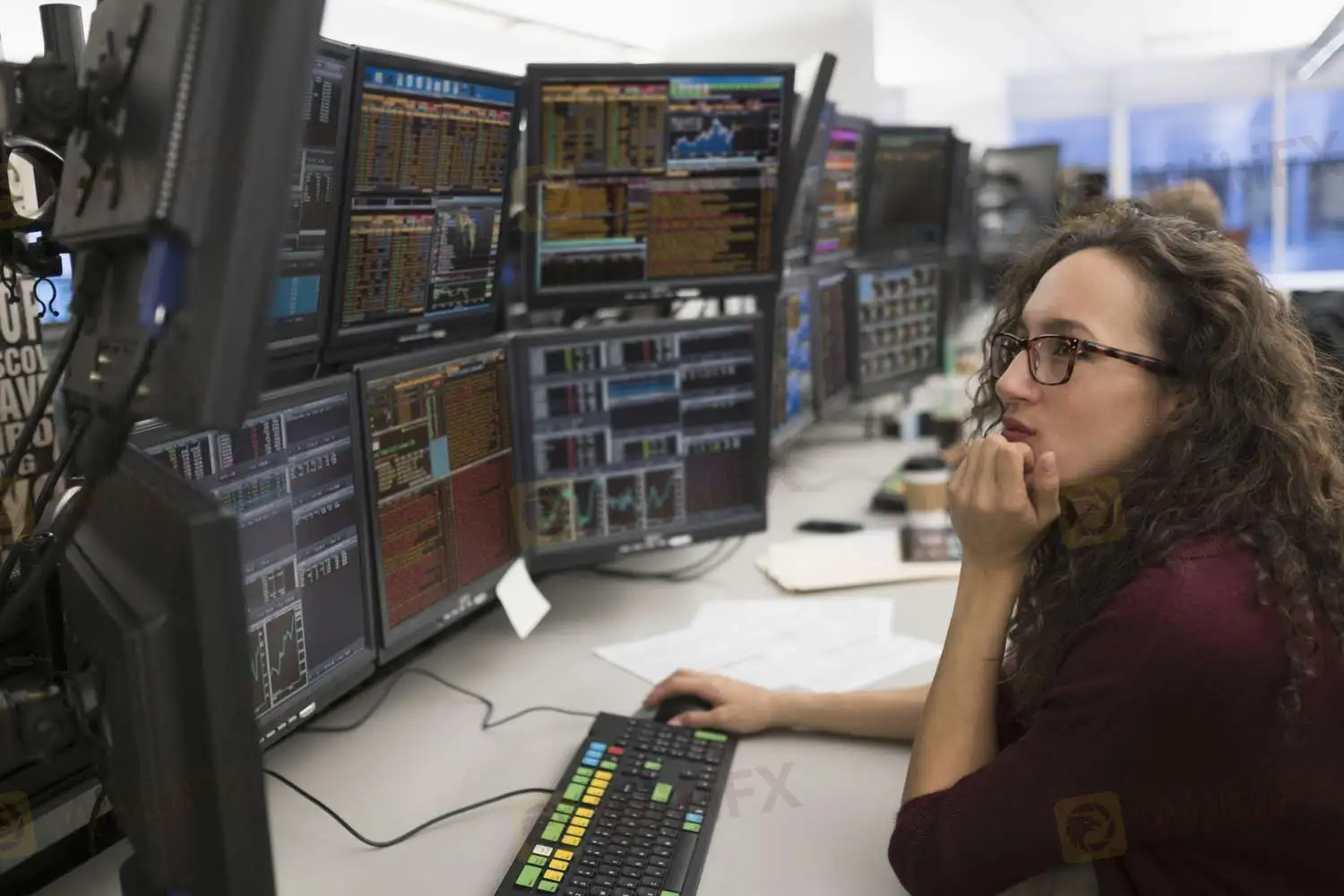简体中文
繁體中文
English
Pусский
日本語
ภาษาไทย
Tiếng Việt
Bahasa Indonesia
Español
हिन्दी
Filippiiniläinen
Français
Deutsch
Português
Türkçe
한국어
العربية
Exploring the World of Commodities Trading: A Comprehensive Analysis
Abstract:Commodity trading offers diversification, potential profit, and a hedge against inflation. Factors like supply and demand, geopolitical unrest, and seasonal variations impact commodity prices. Traders need effective strategies, risk management, and market knowledge to navigate this volatile market successfully.

Commodity trade has a centuries-long history and continues to play an important role in the global economy today. Commodities, which include anything from oil and gas to agricultural items and metals, are the foundation of many companies throughout the globe. Commodity trading provides a unique mix of benefits and dangers, making it an appealing alternative for investors seeking diversity and possible profit.
This in-depth essay seeks to give an in-depth analysis of the world of commodities trading, addressing crucial issues and shed light on its influence on investment portfolios. Readers will acquire vital insights into making educated investing choices by understanding the motivations to trade commodities, the function of supply and demand, the dangers and rewards involved, the link between inflation and geopolitical upheaval, as well as successful trading tactics.
I. Reasons to Trade Commodities
Trading commodities presents investors with several compelling reasons to participate in this dynamic market. First and foremost, commodities have intrinsic value and are integral to everyday life. This fundamental demand ensures a market for commodities, fostering opportunities for profit. Additionally, commodities offer a potential hedge against inflation, as their prices tend to rise during periods of monetary devaluation.
Furthermore, commodities trading allows for portfolio diversification, which allows investors to decrease risk by diversifying their assets across multiple asset classes.
II. Impact of Commodity Trading on Investment Portfolios
Commodity trading has a significant impact on investment portfolios. By including commodities, investors can enhance their portfolio's risk-adjusted returns and reduce overall volatility. Commodities have a low correlation with traditional asset classes like stocks and bonds, which means they can perform differently under various market conditions. This non-correlation enables commodities to act as a counterbalance during periods of economic uncertainty or financial market turbulence, providing a potential buffer against losses in other investments. However, it is important to note that commodities are not immune to volatility themselves, and careful risk management is crucial.
III. The Role of Supply and Demand in Commodity Trading
Supply and demand dynamics are at the heart of commodity trading. Fluctuations in supply, influenced by factors such as weather conditions, geopolitical events, and technological advancements, directly impact commodity prices. Similarly, changes in demand, driven by global economic growth, population trends, and shifts in consumer behavior, can significantly affect prices. Understanding these dynamics and monitoring supply and demand indicators are vital for successful commodity trading. By identifying trends and imbalances, traders can capitalize on price movements and adjust their strategies accordingly.

IV. Risks and Rewards of Trading Commodities
Commodity trading offers both rewards and risks. On one hand, it presents opportunities for substantial profits, as commodity prices can experience significant fluctuations. Successful traders who accurately predict market trends and time their trades effectively can reap substantial financial rewards. On the other hand, commodity trading is not without risks. Market volatility, regulatory changes, geopolitical instability, and unexpected events can lead to sudden price swings, potentially resulting in losses. Risk management, including diversification, setting stop-loss orders, and employing effective trading strategies, is crucial for mitigating risks in this complex market.
V. Commodities as a Hedge Against Inflation
Because of their physical form and finite availability, commodities have traditionally functioned as an inflation hedge. When the value of fiat currencies is eroded by inflation, commodity prices tend to rise due to higher production costs and greater demand. Investing in commodities offers the ability to protect buying power and portfolio value. However, the usefulness of commodities as an inflation hedge might vary based on market circumstances, monetary policy, and the individual commodities under consideration.
Precious metals such as gold and silver are well-known for their capacity to function as an inflation hedge. These metals have been prized for ages and are often sought after during times of economic instability and currency depreciation. Their scarcity, durability, and inherent worth make them appealing to investors as a store of wealth.
Oil is another commodity that has traditionally done well as an inflation hedge. Oil costs tend to grow with inflation as a key energy source for transportation, industry, and other industries. Higher production costs, geopolitical concerns, and supply interruptions may all push higher oil prices during inflationary times.
Furthermore, agricultural commodities such as wheat, maize, and soybeans may operate as inflation hedges. These commodities are necessary for food production, and their prices tend to grow when the cost of production increases. During inflationary periods, demand for certain items stays generally steady, protecting purchasing power.
VI. Geopolitical Unrest and its Impact on Commodity Prices and Trading
Geopolitical unrest has a profound influence on commodity prices and trading. Political tensions, wars, and trade disputes between countries may affect commodity production, shipping, and distribution, causing supply interruptions and price volatility. Geopolitical upheaval in oil-producing countries, for example, might lead to decreased oil supply or threats to shipping routes, leading oil prices to skyrocket.
Similarly, trade tensions between countries can result in tariffs or embargoes on certain commodities, affecting their availability and driving up prices. Understanding geopolitical developments and their potential impact on commodity markets is essential for traders to anticipate and adapt to market fluctuations effectively.
VII. Strategies for Successful Commodity Trading
Successful commodity trading requires a well-thought-out strategy and disciplined approach. Here are some key strategies to consider:
Fundamental Analysis: This involves analyzing supply and demand factors, geopolitical events, weather patterns, and economic indicators to assess the underlying value of a commodity.
Technical Analysis: Traders use historical price patterns, charts, and mathematical indicators to identify trends, support and resistance levels, and entry and exit points.
Risk Management: Risk management tactics like establishing stop-loss orders, diversifying the portfolio, and adjusting position sizes are critical for mitigating possible losses.
Knowledge and Research: Staying informed about market news, industry trends, and regulatory changes is essential for making informed trading decisions.
Developing a Trading Plan: A well-defined trading plan outlines specific objectives, risk tolerance, entry and exit strategies, and trade management rules.

VIII. Commodity Trading vs. Trading Other Asset Classes
Commodity trading differs from trading other asset classes like stocks or bonds in several ways. Firstly, commodities are physical goods, whereas stocks represent ownership in a company, and bonds represent debt.
Secondly, commodity markets operate on different supply and demand dynamics, influenced by factors such as weather, global demand, and geopolitical events. Additionally, commodities are subject to unique regulations and market structures, including futures trading and storage considerations. Traders need to familiarize themselves with these distinctions to navigate the commodity markets effectively.
IX. The Importance of Diversification in Commodity Trading
Diversification is vital in commodity trading to manage risk effectively. Traders may decrease their exposure to price volatility or supply interruptions by diversifying their assets among commodities, industries, and locations. Diversification helps to balance a portfolio's risk-reward profile and may boost long-term performance. Furthermore, since commodities frequently have a low connection with other asset classes, having them in a diversified investment portfolio may help offset losses during economic downturns.
X. Commodity Trading's Role in the Global Economy
Commodities play an important role in the global economy. They are raw materials utilized in a variety of sectors such as agriculture, industry, energy, and construction. Commodity supply and demand dynamics are directly linked to global economic growth and development. Furthermore, commodity-rich countries depend largely on the export of these resources for economic stability and prosperity. Commodity trading supports the efficient movement of these resources across borders, allowing producers and consumers to manage their supply chain requirements. As a result, the performance of commodities markets may both reflect and impact the general health of the global economy.
XI. Getting Started with Commodity Trading
To get started with commodity trading, investors need to undertake several key steps. Firstly, acquiring knowledge about the commodity markets, trading mechanisms, and relevant regulations is essential. Next, opening a brokerage account that provides access to commodity markets is necessary. Traders should conduct thorough research on the commodities they wish to trade, including understanding their supply and demand dynamics, price trends, and market fundamentals. It is critical to have a trading strategy that details goals, risk tolerance, and trading tactics. It is also critical to keep up with market news, economic statistics, and geopolitical happenings that may have an influence on commodity prices. Finally, a wise method is, to begin with a modest investment and progressively increase exposure as one acquires expertise and confidence.
XII. Impact of Seasonal Variations on Commodity Trading
Seasonal variations have a significant impact on commodity trading. Many commodities are affected by seasonal elements such as weather, agricultural cycles, and consumer demand patterns. Agricultural commodities, such as wheat and maize, are susceptible to planting and harvesting seasons, which may impact supply and pricing.
Energy commodities like natural gas and heating oil experience increased demand during winter months. Understanding and anticipating these seasonal patterns allows traders to capitalize on price fluctuations and adjust their trading strategies accordingly. Furthermore, seasonal variations can create opportunities for spread trading, where traders simultaneously buy and sell related contracts to profit from price differentials between different months or seasons.
XIII. Common Commodities to Trade and Their Popularity
Several commodities are popular among traders due to their liquidity, volatility, and global significance. Some common commodities include:
Crude Oil: As the most actively traded commodity, crude oil's importance in transportation, manufacturing, and energy production makes it a popular choice for traders.
Gold: Known as a safe-haven asset, gold attracts investors during times of economic uncertainty and is often traded as a store of value.
Natural Gas: Used for heating, electricity generation, and industrial processes, natural gas is traded actively, influenced by factors like weather, supply levels, and global demand.
Agricultural Commodities: Wheat, corn, soybeans, coffee, and sugar are among the most traded agricultural commodities. Their prices are impacted by factors such as weather conditions, crop yields, and global food demand.
Base Metals: Copper, aluminum, zinc, and nickel are widely traded due to their industrial applications and their use in infrastructure and manufacturing sectors.
Precious Metals: Besides gold, silver, platinum, and palladium are popular among traders due to their value as investment assets and their usage in jewelry, electronics, and automotive industries.
XIV. Futures Trading in the Commodities Market
In the commodities market, futures contracts are a common trading tool. A futures contract is an agreement to purchase or sell a particular amount of a commodity at a future date and price. Market players may use futures trading to speculate on price changes, hedge against price risks, and manage their exposure to commodities. Futures markets provide liquidity, transparency, and standardized contracts, allowing for more efficient price discovery. It is crucial to understand, however, that futures trading includes leverage and bears inherent risks, including the possibility of severe losses if market moves are negative. Before participating in futures trading, traders should have a full grasp of futures contracts, margin requirements, and risk management measures.
XV. Understanding the Commodities Market and Enhancing Trading Strategies
Understanding the complexities of the commodities market is critical for traders who want to improve their overall trading methods. Traders may acquire useful insights into commodity price fluctuations by evaluating supply and demand dynamics, watching economic data, and keeping up current on market news. Furthermore, technical analysis tools like chart patterns, indicators, and trend analysis may aid in identifying probable entry and exit points. Recognizing the connection between commodities, currencies, and global economic trends may help to develop trading methods. Incorporating risk management measures, maintaining diverse portfolios, and continually learning and reacting to market situations are critical components in enhancing overall trading tactics.
XVI. The Volatility of Commodity Trading
Commodity trading is often considered a volatile market due to various factors. One significant factor is the inherent sensitivity of commodities to supply and demand imbalances. Weather conditions, geopolitical events, and technological advancements can cause sudden disruptions in supply, leading to significant price fluctuations. Additionally, commodities can be influenced by speculative trading and investor sentiment, which can amplify price volatility.
Moreover, commodities are subject to macroeconomic factors such as global economic growth, interest rates, and currency fluctuations. Changes in these factors can impact commodity prices and create volatility in the market. For example, a slowdown in global economic growth can lead to reduced demand for commodities, affecting their prices. Similarly, changes in interest rates or currency values can influence the cost of production and impact commodity prices.
Furthermore, commodities often exhibit seasonal patterns and cyclical trends. These patterns can result in periods of increased price volatility as demand and supply dynamics change throughout the year. Traders need to be aware of these patterns and adjust their trading strategies accordingly to navigate volatile market conditions.
It is important to note that while volatility presents risks, it also creates opportunities for profit. Skilled commodity traders who can accurately anticipate and respond to market movements can benefit from price volatility. Volatile markets provide the potential for significant price swings, allowing traders to capture profits through well-timed trades and effective risk management strategies.
XVII. Benefits and Drawbacks of Commodity ETFs (Exchange Traded Funds)
Commodity ETFs, which are investment funds that track the performance of a specific commodity or a basket of commodities, offer several benefits and drawbacks to investors.
Benefits:
Diversification: Commodity ETFs provide investors with exposure to a wide range of commodities without the need to individually trade each commodity. This diversification helps spread risk and can enhance portfolio performance.
Accessibility: Commodity ETFs are easily accessible through brokerage accounts, allowing investors to participate in the commodity market without the need for specialized knowledge or trading expertise.
Liquidity: ETFs trade on exchanges, providing investors with liquidity and the ability to buy or sell shares throughout the trading day at market prices.
Transparency: ETFs disclose their holdings on a regular basis, allowing investors to know the specific commodities included in the fund and their respective weightings.
Drawbacks:
Tracking Error: Commodity ETFs may not perfectly track the performance of the underlying commodities due to factors such as management fees, trading costs, and the rollover process for futures contracts.
Contango and Backwardation: Commodity ETFs that invest in futures contracts can be affected by market conditions known as contango (when futures contracts are more expensive than spot prices) or backwardation (when futures contracts are cheaper than spot prices). These conditions can impact ETF returns.
Complexity: Some commodity ETFs utilize complex strategies, such as leveraged or inverse exposure, which can increase risk and may not be suitable for all investors.
Lack of Physical Ownership: Unlike owning physical commodities, investing in commodity ETFs provides only indirect exposure to the underlying assets. Investors do not directly own the physical commodities.
XVIII. The Performance of the Overall Economy and Commodity Prices
Commodity prices are heavily influenced by the general functioning of the economy. Commodity prices are heavily influenced by economic variables such as global GDP growth, industrial output, and consumer demand.
When the economy is healthy, commodity demand rises because businesses need raw resources for production and consumers have more buying power.
In contrast, demand for commodities may fall during economic downturns or recessions. Reduced industrial activity, less consumer spending, and poorer global commerce may all contribute to lower commodity prices.
commodities prices. Furthermore, during economic downturns, investors may move their emphasis to safer investments, which may have an influence on commodity prices.
Commodity price changes are also influenced by monetary policy and interest rates. Central banks' interest rates and monetary stimulus policies may have an impact on borrowing costs, currency exchange rates, and inflation levels. These variables, in turn, may have an influence on commodity demand and pricing.
Furthermore, global economic and geopolitical events may have a significant impact on commodity prices. Trade wars, political turmoil, natural catastrophes, and regulatory changes may all disrupt supply networks, damage production capacity, and cause volatility in commodities markets. These occurrences have the potential to cause heightened volatility and large price swings.
XIX. Factors to Consider when Choosing a Commodity to Trade
When choosing a commodity to trade, several factors should be taken into consideration:
Market Understanding: Gain a deep understanding of the specific commodity, including its supply and demand dynamics, market fundamentals, pricing mechanisms, and any unique factors that influence its performance.
Volatility and Liquidity: Assess the historical volatility of the commodity to understand its price movements and associated risks. Additionally, consider the liquidity of the commodity market to ensure ease of buying and selling positions.
Global Economic Factors: Evaluate the commodity's sensitivity to global economic trends, such as GDP growth, industrial production, and consumer demand. Consider how changes in the overall economy may impact the commodity's performance.
Seasonality and Cyclical Patterns: Analyze any seasonal or cyclical patterns that may affect the commodity's price fluctuations. Understanding these patterns can help identify potential trading opportunities.
Geopolitical Factors: Take into account geopolitical events and their potential impact on the commodity market. Consider how political tensions, conflicts, and regulatory changes may influence supply, demand, and prices.
Risk Appetite: Assess your risk tolerance and match it with the inherent risks associated with trading the chosen commodity. Some commodities may exhibit higher volatility and risk levels than others.
Trading Instruments: Determine the availability of trading instruments for the chosen commodity, such as futures contracts, options, or ETFs. Ensure that the chosen instruments align with your trading strategy and preferences.
Research and Analysis Resources: Consider the availability of reliable research and analysis resources specific to the chosen commodity. Access to historical data, market reports, and expert analysis can enhance decision-making capabilities.
XX. The Importance of Commodities in a Diversified Investment Portfolio
Including commodities in a diversified investment portfolio offers several benefits:
Risk Mitigation: Commodities have historically exhibited a low or negative correlation with traditional asset classes such as stocks and bonds. This means that during periods of market turbulence or economic downturns, commodities may provide a hedge and potentially mitigate losses in other investments.
Inflation Protection: Commodities have the potential to act as a hedge against inflation. As commodity prices tend to rise during inflationary periods, holding commodities in a portfolio can help preserve purchasing power.
Portfolio Diversification: Commodities offer a unique risk-return profile compared to other asset classes. Adding commodities to a diversified portfolio reduces the portfolio's overall risk by spreading investments across different types of assets.
Potential for Enhanced Returns: Commodities, due to their intrinsic value and sensitivity to global economic factors, have the potential to generate attractive returns over the long term. By including commodities in a portfolio, investors can tap into these opportunities for capital appreciation.
Capturing Cyclical Opportunities: Commodities often exhibit cyclical price movements. These cycles can be driven by factors such as supply and demand imbalances, economic cycles, and seasonal patterns. By including commodities in a portfolio, investors have the potential to capture these cyclical opportunities and benefit from price fluctuations.
Portfolio Stability: Adding commodities to a diversified portfolio can help stabilize its overall performance. Since commodities have a low correlation with other asset classes, they can provide diversification benefits and reduce the portfolio's overall volatility.
Long-Term Growth Potential: The global demand for commodities is driven by population growth, urbanization, and industrial development. As emerging economies continue to expand, the demand for commodities is expected to rise, potentially leading to long-term growth opportunities for investors.
Currency Diversification: Some commodities, such as gold and precious metals, can serve as a hedge against currency fluctuations. Including these commodities in a portfolio can provide diversification benefits by reducing exposure to a single currency.
It is vital to remember that, although commodities have potential advantages, they also have hazards. Commodity prices may be volatile, and commodity investment requires thorough risk management and market research. Furthermore, commodities are vulnerable to regulatory, geopolitical, and environmental hazards, all of which may have an influence on their performance.
Conclusion
Commodity trading provides investors with both distinct possibilities and problems. Understanding the reasons to trade commodities, the impact on investment portfolios, the role of supply and demand, the risks and rewards involved, the relationship with inflation and geopolitical unrest, effective trading strategies, and the importance of diversification are critical factors in navigating this volatile market.
Commodities play an important role in the global economy, supplying the raw materials required by numerous businesses and reflecting the general health of the economy. By integrating commodities in a diversified investment portfolio, investors may possibly improve risk-adjusted returns, reduce inflation concerns, and capitalize on cyclical opportunities.
Commodity trading, on the other hand, requires extensive study, risk management, and a methodical approach. Investors should keep current on market movements, watch global economic trends, and adjust their tactics appropriately. With careful study and a thorough grasp of commodity markets, investors may maximize the potential rewards of commodity trading while efficiently controlling risks.
Download and install the WikiFX App on your smartphone to stay updated on the latest news.
Download the App here: https://social1.onelink.me/QgET/px2b7i8n

Disclaimer:
The views in this article only represent the author's personal views, and do not constitute investment advice on this platform. This platform does not guarantee the accuracy, completeness and timeliness of the information in the article, and will not be liable for any loss caused by the use of or reliance on the information in the article.
Read more

Top 10 Trading Indicators Every Forex Trader Should Know
Master the top 10 Forex trading indicators to analyze real-time Forex quotes, trends, and market signals. Learn strategies to boost accuracy and avoid mistakes.

Why Do You Feel Scared During Trade Execution?
Trade execution is a pivotal moment for traders. It is when analysis turns into action, and potential profits or losses become reality. However, for many traders, this moment is accompanied by fear. Why does this happen, and how can you address it?

WikiEXPO Global Expert Interview: Simone Martin—— Exploring Financial Regulation Change
In the midst of financial innovation and regulation, WikiGlobal, the organizer of WikiEXPO, stays abreast of industry trends and conducts a series of insightful and distinctive interviews on pivotal topics. We are delighted to have the privilege of inviting Simone Martin for an in-depth conversation this time.

MultiBank Group Wins Big at Traders Fair Hong Kong 2024
Discover how MultiBank Group, a global leader in financial derivatives, secured three prestigious awards at Traders Fair Hong Kong 2024, highlighting its innovative trading solutions and industry excellence.
WikiFX Broker
Latest News
Geopolitical Events: What They Are & Their Impact?
Top 10 Trading Indicators Every Forex Trader Should Know
Why Do You Feel Scared During Trade Execution?
Currency Calculator


